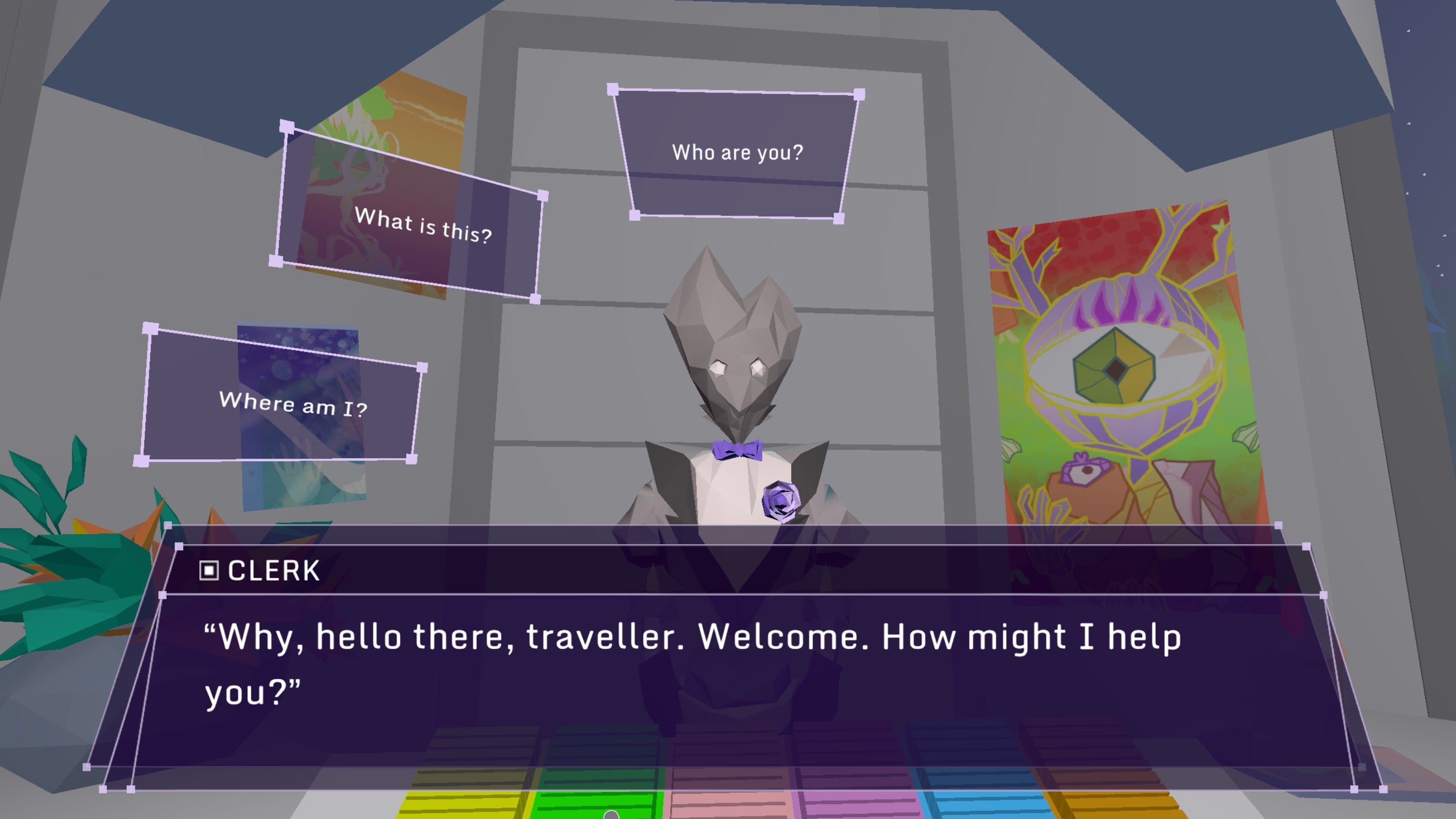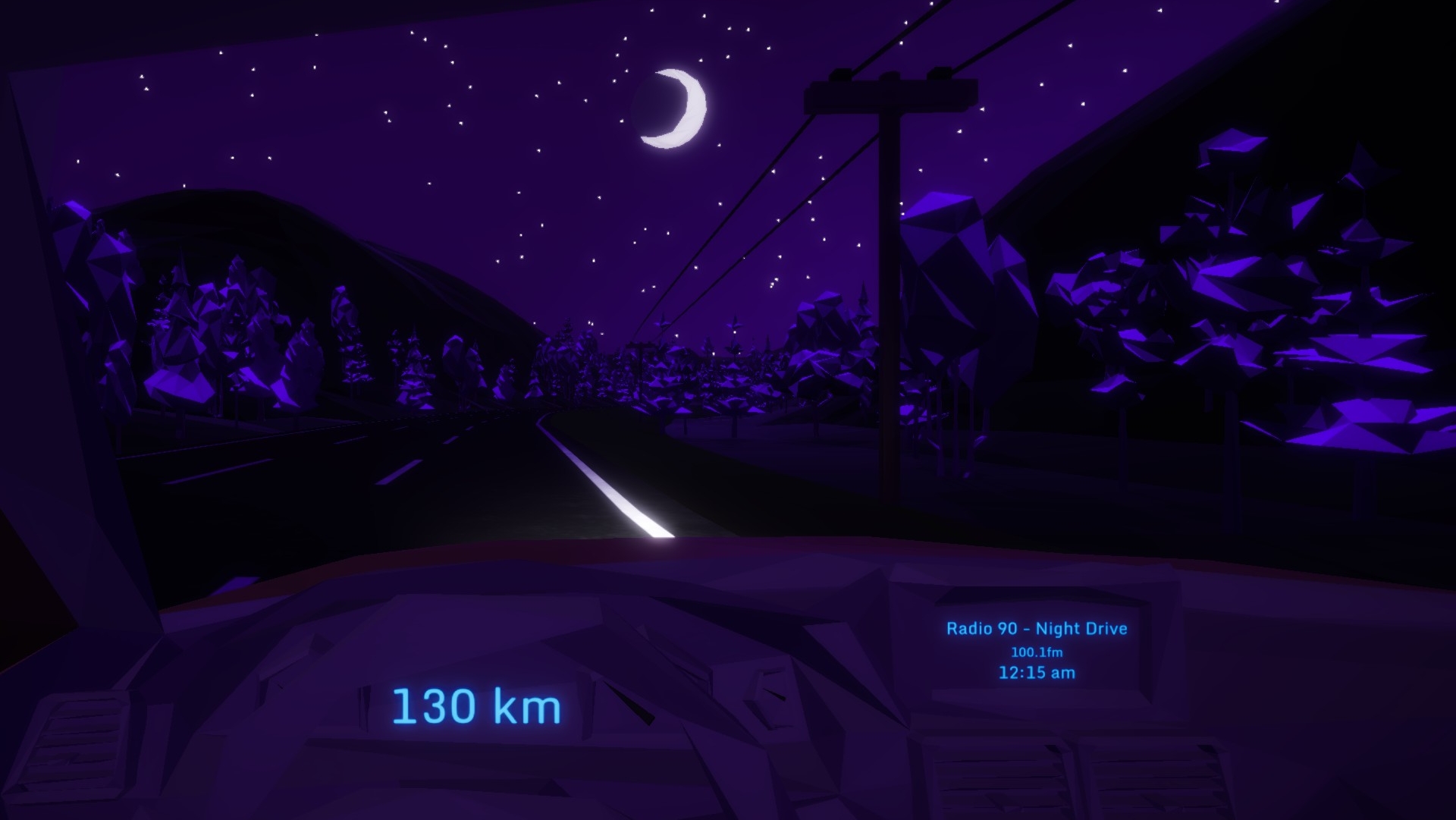Whether we are talking about
Glitchhikers: First Drive (2014), or
Glitchhikers: The Spaces Between, one thing is certain—the Glitchhikers Experience cannot be separated from the strange and unforgettable in-game music. Fans old and new will invariably point to the original soundtrack as the siren song that drew them into the world, made them comfortable to sink into the surreality, and brings them back time after time.
When we sat down to make The Spaces Between we knew that building upon the 6 song First Drive OST was going to present an exciting challenge. The Glitchhikers sound is so particular yet so difficult to nail down. It is in many ways an amalgamation of mangled pieces of several genres, held together by a membrane of synth-laden loops. Each one is more than the sum of its parts, like musical mosaics constructing a full picture out of shattered fragments of songs.

To give you a deeper look into our journey recreating and reimagining this alchemic magic, we went directly to the source -- Devin Vibert, Silverstring’s Musical Lead and composer of the songs of both First Drive and The Spaces Between.
[h3]Can you tell us what makes a Glitchhikers song? What are you hoping for when you sit down to create one?[/h3]The music in Glitchhikers and Glitchhikers: The Spaces Between is meant to be a little weird, a little broken, and at times a little beautiful. A lot of the music is very ephemeral; songs will drift between (or use simultaneously) seemingly disparate styles or moods. This is much like some of the interactions a player will have: a strange hiker has an interesting and often meandering conversation with them, before they disappear into the night or the player moves on.
Above all else, the music is meant to be meditative—like many of the other design aspects of the game, it’s meant to leave space for the player to have whatever experience they’re prepared to have. That said, I very much wanted to (at risk of using a hackneyed term) play with liminality in the music, and so a lot of the songs are built from these weird bits of musical flotsam and jetsam.
 [h3]Did you pull this concept from the ether or were you drawing inspiration from something? Did you have any guiding stars?[/h3]
[h3]Did you pull this concept from the ether or were you drawing inspiration from something? Did you have any guiding stars?[/h3]Both [Claris Cyarron, Creative Director and Collaborating Composer] and I have looked to
The Disintegration Loops as a source of inspiration for this type of “audio-destruction-turned-pretty” aesthetic, and you can hear it all over the place. A song might, for example, start with a badly distorted loop ripped from an earlier version of a different song stuck with a melody made by a malfunctioning synth patch that drifts into a reverb-soaked piano and an acoustic guitar part that has been so badly time-stretched that it’s riddled with audio artefacts. There were some other songs and artists that have inspired the music of The Spaces Between, and I have put together
a playlist of sorts on YouTube highlighting the, er, most telling ones.
[h3]Is there a particular connecting thread to these songs that you are most drawn to? What gives something the spirit of a Glitchhikers song across genres or structural differences?[/h3]A lot of the best (imho) parts of the soundtrack are those songs where several seemingly busted pieces of audio are smashed together to create something actually musically coherent; I leaned hard into a lot of lo-fi sounds. Sometimes I intentionally time-stretched audio using the wrong algorithms and then would challenge myself to make it sound cool and interesting. If I was having trouble with a song, I’d cannibalize an unused (or already-used, I didn’t mind!) section from another track and process it to the point where it was barely recognizable, and use it to blow the creative block wide-open. Some melodies are completely improvised and were recorded in a single take and never altered.
[h3]The Spaces Between was a much larger undertaking than the shorter, tighter experience of First Drive. To compare, First Drive had one journey mode and 6 songs total, while The Spaces Between has four main modes and a whopping 5-Volume, 71 track Deluxe OST.
Could you give us some insight into your process for each journey, starting with The Highway (the most similar mode to First Drive)?[/h3]We wanted to cleave pretty closely to what we did in OG Glitchhikers, which was for the music to be a little unsettling and broken, but for it to still manage to be somewhat chill and meditative—a tricky line to walk. The music also needed to stay out of the way of the conversations the player would be having, so early on it was decided that these songs would be light on lyrical content and should be able to play in the background without being particularly disruptive. We did want to expand the repertoire of the Drive music a bit, adding elements of jazz, lo-fi, and lounge whilst still hanging on to the chopped-up-and-shuffled audio aesthetic that made it what it was in the OG.
 [h3]The Path mode (where players are free to walk through many winding paths of a park with music being delivered using a “Glitchpod”) is a pretty different thematic and mechanical experience to The Highway. How did that influence your approach?[/h3]
[h3]The Path mode (where players are free to walk through many winding paths of a park with music being delivered using a “Glitchpod”) is a pretty different thematic and mechanical experience to The Highway. How did that influence your approach?[/h3]The Path necessitated a different approach to composition—you’re listening to songs between segments of a podcast, and so the music is the sole focus of the audio experience (unless you turn your GlitchPod off, which I recommend everyone do on occasion because silence is also nice, and I find the ambience of the Path very soothing!). For the reasons above, and because the Path is decidedly a more active experience than the Highway, we wanted the music to be more upbeat, convey a stronger sense of wonder and intrigue, focus on nature/the living world, and to generally inhabit “the present”. Thus, many of the songs for the Path journey have lyrics, stronger melodies, a faster tempo, and very generally use a lot more transients (“fast” sounds like a clap or plucked strings) when compared to songs for the Highway.
 [h3]The Railway is a journey that we've described as more communal and warm. It has the most in common with The Highway in many respects, but musically is probably one of the bigger departures from First Drive. Tell me about your thought process for that?[/h3]
[h3]The Railway is a journey that we've described as more communal and warm. It has the most in common with The Highway in many respects, but musically is probably one of the bigger departures from First Drive. Tell me about your thought process for that?[/h3]Pretty much by default, the Railway journey was going to require an atypical approach to the music. Trains don’t normally blare radio music throughout, but without any music it would feel a bit empty. Almost right from the start of development we were into the idea of a busker lightly playing music in each train car, but we wanted to ensure this didn’t get grating to the listener after a little while. From this blossomed the idea that in each car, the busker would be playing different instruments, and different parts of the same song. Since the sound bleeds through from adjacent cars, you’d hear multiple copies of the busker harmonizing or playing along with each other in a disjointed, multiple-train-car jam session.
The intent was for the railway to be a safer and more comfortable space than with the other journeys, so it was decided that the music would have a warmer, more organic feel than the other journeys. There are virtually no synths, (though in-game the busker technically is using a synthesizer to play string and brass samples sometimes), and most of the instrumentation should feel pretty familiar to most folks—guitar, drums, bass, piano, strings, brass, nothing too crazy. (I did use an aluphone a bunch too, but shhhh)
 [h3]You've spoken before about The Terminal mode as being the one with the most control, both in terms of absolute freedom for players to explore the environment, and in terms of musical control. In some ways it is the least First Drive-like mode, and yet it takes the spirit of musical experimentation and the stitching together of disparate and broken sounds to its extreme. How would you explain it?[/h3]
[h3]You've spoken before about The Terminal mode as being the one with the most control, both in terms of absolute freedom for players to explore the environment, and in terms of musical control. In some ways it is the least First Drive-like mode, and yet it takes the spirit of musical experimentation and the stitching together of disparate and broken sounds to its extreme. How would you explain it?[/h3]The music in the Terminal is this ethereal, looping vapourwave behemoth that slowly morphs, adding and removing parts and instruments depending not just where in the space the player travels, but how they do it as well. Effectively Claris and I wanted to have the entire Terminal function as a giant, bespoke player-controlled synthesizer, where their actions (and a few procedural things) could affect the sound just as someone might twist a filter knob or punch in a loop. The hope was that folks would find enjoyment just in playing around with these sounds as they also played around in the space. The Hikers we encounter in the Terminal also act as mini-synths: each one emits looping melodies unique to their personality that can change depending on a variety of different player actions/choices.
With that, we decided to wrap the interview and leave more musical mysteries and surprises for players to uncover for themselves when Glitchhikers: The Spaces Between drops March 31st for PC, Mac and Nintendo Switch (you can find information on available platforms on the newly redesigned
glitchhikers.com). The 22-track OST and the 5-volume Deluxe Soundtrack that contains all 71 in-game songs will also be available from Day 1 as part of bundles, with more outlets TBA. Until then, you can find the three singles that have been released on
Devin’s Bandcamp, with official Music Videos available on
Silverstring Media’s YouTube.
[h3]To hear more from Devin and Claris about the Sights and Sounds of Glitchhikers: The Spaces Between you can
watch their showcase from Steam Next Fest. [/h3]







